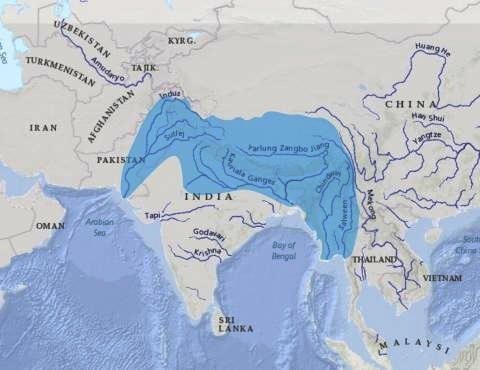Climate Change Report on Hindukush Karakoram Ranges | 11 Feb 2021
Why in News
According to the 'Assessment of Climate Change over the Indian Region' report, snowfall over the higher reaches of the Hindukush Himalayan mountain ranges has been increasing in recent decades, which has shielded the region from glacier shrinkage.
- The recent massive flooding in the Alaknanda river, probably due to glacial bursts has highlighted the issue of higher glacier retreat in recent decades due to global warming, however, the report indicates a contrasting picture of the Hindukush Himalayas.
- Assessment of Climate Change over the Indian Region Report has been published by the Ministry of Earth Sciences (MoES). It is India’s first-ever national forecast on the impact of global warming on the subcontinent in the coming century.
HinduKush Himalayan (HKH) Region
- The HKH region spans Afghanistan, Bangladesh, Bhutan, China, India, Kyrgyzstan, Mongolia, Myanmar, Nepal, Pakistan, Tajikistan, and Uzbekistan.
- It traverses about 5 million square kilometres and hosts a large and culturally diverse population.
- It is considered the Third Pole (after the North and South Poles), and has significant implications for climate.
- It contains vast cryospheric zones (frozen water parts) and is also the world’s largest store of snow and ice outside the polar region.
Key Points
- Findings of the Report:
- Several areas of Hindukush Karakoram Himalayas have experienced a declining trend in snowfall and also retreat of glaciers in recent decades.
- In contrast, the high-elevation Karakoram Himalayas have experienced higher winter snowfall that has shielded the region from glacier shrinkage.
- The Karakorams are part of a complex of mountain ranges at the centre of Asia, including the HinduKush to the west, the Pamirs to the northwest, the Kunlun Mountains to the northeast, and the Himalayas to the southeast.
- Even when the winter snowfall has increased over the high-elevation Karakoram Himalayas, the overall climate along the Hindukush Karakoram region is undergoing warming at a higher rate during the winter season as compared to other seasons.
- Reasons:
- Faster Heating of Himalayas:
- Weather dynamics is intricate in the Himalayan region, arising due to extensive interactions of tropical and extratropical weather systems.
- The Himalayas have been warming at a faster rate than the rest of Indian landmass during 1951 - 2018.
- Besides, the warming reported from this region is higher than global mean temperatures.
- Global Warming:
- The decadal warming trend recorded over these ranges from 1951 to 2014 was 1.3 degree Celsius. This is a rise from 0.16 degree Celsius recorded from 1900 to 1950, when global warming was less pronounced.
- Faster Heating of Himalayas:
- Effect:
- Increasing Annual Mean Surface Temperature:
- The Report has forecast an increase in annual mean surface temperature by 2.2 degree Celsius during 2040 - 2069 and a further increase by 3.3 degree Celsius during 2070 – 2099, along these ranges.
- Extreme Precipitation:
- Due to this warming trend, there is an expected increase in the precipitation projected over the region. It is predicted that there will be a significant increase in extreme precipitation over the Hindukush Karakoram region, with maximum consecutive five-day precipitation events.
- Increasing Annual Mean Surface Temperature:
- Significance:
- Driver of Monsoon: The Hindukush Karakoram ranges, along with the Tibetan Plateau, are the main drivers of the Indian Summer Monsoon.
- Source of Subsistence: These ranges form the source to 10 major river systems in Asia, supporting drinking water, irrigation and power supply to 1.3 billion people in the continent.
- Major Indian rivers which replenish due to the melted snow are Indus, Ganges and Brahmaputra.
- After the North and the South poles, the Hindukush – Karakoram ranges, along with the Tibetan Plateau, hold the largest reserves of freshwater.

